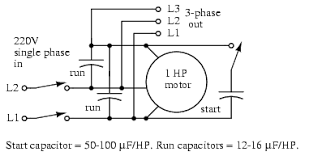Pull up the grizzly manual::
http://cdn2.grizzly.com/manuals/g0730_m.pdf
and turn to page 39 and 40.
Here we see the wiring diagram that allows the motor to be switched from 120V to 230V. Notice that there are 6 wires coming out of the motor, and start and run capacitors <somehow connected to the motor. In the 210V configuration 3 of the motor wires are connected together, in the 210V configuration three (3) sets of wires are connected individually together.
NOTE: the terminal numbering in this manual does not correspond to the terminal numbering in ANSI motor wiring specs. But otherwise is illustrative of the dual voltage wiring.
{Aside: there are induction motors of low HP levels that are single phase only--for things like refrigerators,... We are not talking about these--we are talking about motors with significant power (> 1HP) but more importantly those that can be reversed in direction.}
Next pull up:
http://css.wsu.edu/wp-content/uploads/2012/09/Motors1.pdf
and go to page 326 in the book, page 10 in the chapter PDF.
Dual voltage motors can be used in Wye (Y) style (fig 16-25) but can equally be used in Delta style as (fig 16-26). In the low voltage configuration coils are run in parallel, in the high voltage configuration coils are run in series. The Grizzly manual is showing the Delta configuration of dual voltage operation but in 120V<->210V whereas the PDF is showing 230V<->460V.
In the single phase configuration, a capacitor is used to create the third phase.
By gaining access to the third pole, and removing the capacitor, the reversible induction motor is perfectly happy to run on 3-phase power.
Running with a correctly spec'ed capacitor, the 1-phase version delivers 83% of the motors HP capability compared to the same motor running in 3-phase with the same voltages.
ETA: Question 12 at the end of the chapter illustrates the purported wiring of the motor in question.
My previous statement needs to be modified to include the ability to reverse motor direction. This implies that there are actually 3 phases of coils in the motor. Irreversible inductions motors need only 2 sets of coils, and always have to have a capacitor--these are typically reserved for low voltage (120V) and lower power, refrigerators, fans,...
My previous statement might also need to be modified to include the dual voltage option--but my EE training ended in 1975 and I can't remember.


